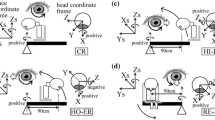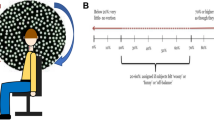Abstract
Human horizontal rotational vestibulo-ocular reflex (rVOR) has been extensively investigated: the horizontal semicircular canals sense yaw rotations with high-pass filter dynamics and a time constant (TC) around 5 s, yet the rVOR response shows a longer TC due to a central processing stage, known as velocity storage mechanism (VSM). It is generally assumed that the vertical rVOR behaves similarly to the horizontal one; however, VSM processing of the human vertical rVOR is still to be proven. We investigated the vertical rVOR in eight healthy human subjects using three experimental paradigms: (1) per- and post-rotatory around an earth-vertical axis (ear down rotations, EDR), (2) post-rotatory around an earth-horizontal axis with different stopping positions (static otolith stimulation), (3) per-rotatory around an earth-horizontal axis (dynamic otolith stimulation). We found that the TC of vertical rVOR responses ranged 3–10 s, depending both on gravity and on the direction of rotation. The shortest TC were found in response to post-rotatory earth-horizontal stimulation averaging 3.6 s, while they were prolonged in EDR stimulation, i.e. when the head angular velocity vector is aligned with gravity, with a mean value of about 6.0 s. Overall, the longest TC were observed in per-rotatory earth-horizontal stimulation, averaging 7.8 s. The finding of longer TC in EDR than in post-rotatory earth-horizontal stimulation indicates a role for the VSM in the vertical rVOR, although its contribution appears to be weaker than on the horizontal rVOR and may be directionally asymmetric. The results from per-rotatory earth-horizontal stimulation, instead, imply a role for the otoliths in controlling the duration of the vertical rVOR response. We found no reorientation of the response toward earth horizontal, indicating a difference between human and monkey rVOR.





Similar content being viewed by others
Abbreviations
- ANOVA:
-
Analysis of variance
- EDR:
-
Ear down rotation
- OKN:
-
Optokinetic nystagmus
- OKAN:
-
Optokinetic after-nystagmus
- OKR:
-
Optokinetic reflex
- OVAR:
-
Off-vertical axis rotation
- rVOR:
-
Rotational vestibulo ocular reflex
- SCC:
-
Semicircular canals
- SPV:
-
Slow phase velocity
- TC:
-
Time constant
- VSM:
-
Velocity storage mechanism
References
Angelaki DE, Hess BJ (1994) Inertial representation of angular motion in the vestibular system of rhesus monkeys. I. Vestibuloocular reflex. J Neurophysiol 71:1222–1249
Angelaki DE, Hess BJ (1995) Inertial representation of angular motion in the vestibular system of rhesus monkeys. II. Otolith-controlled transformation that depends on an intact cerebellar nodulus. J Neurophysiol 73:1729–1751
Angelaki DE, Green AM, Dickman JD (2001) Differential sensorimotor processing of vestibulo-ocular signals during rotation and translation. J Neurosci 21:3968–3985
Angelaki DE, Shaikh AG, Green AM, Dickman JD (2004) Neurons compute internal models of the physical laws of motion. Nature 430:560–564
Baloh RW, Richman L, Yee RD, Honrubia V (1983) The dynamics of vertical eye movements in normal human subject. Aviat Space Environ Med 54:33–38
Benson AJ, Bodin MA (1965) Effect of orientation to the gravitational vertical on nystagmus following rotation about a horizontal axis. Acta Otolaryngol 61:517–526
Bertolini G, Bockisch CJ, Straumann D, Zee D, Ramat S (2008a) Do humans show velocity-storage in the vertical rVOR? Prog Brain Res 171:207–210
Bertolini G, Bockisch CJ, Straumann D, Zee DS, Ramat S (2008b) Estimating the time constant of pitch rVOR by separation of otoliths and semicircular canals contributions. Conf Proc IEEE Eng Med Biol Soc 2008:1060–1063
Bockisch CJ, Straumann D, Haslwanter T (2005) Human 3-D aVOR with and without otolith stimulation. Exp Brain Res 161:358–367
Bos JE, Bles W (2002) Theoretical considerations on canal-otolith interaction and an observer model. Biol Cybern 86:191–207
Clement G (2003) A review of the effects of space flight on the asymmetry of vertical optokinetic and vestibulo-ocular reflexes. J Vestib Res 13:255–263
Clement G, Lathan CE (1991) Effects of static tilt about the roll axis on horizontal and vertical optokinetic nystagmus and optokinetic after-nystagmus in humans. Exp Brain Res 84:335–341
Cohen B, Henn V, Raphan T, Dennett D (1981) Velocity storage, nystagmus, and visual-vestibular interactions in humans. Ann N Y Acad Sci 374:421–433
Cohen B, Helwig D, Raphan T (1987) Baclofen and velocity storage: a model of the effects of the drug on the vestibulo-ocular reflex in the rhesus monkey. J Physiol 393:703–725
Cohen B, Wearne S, Dai M, Raphan T (1999) Spatial orientation of the angular vestibulo-ocular reflex. J Vestib Res 9:293–301
Collewijn H, van der Steen J, Ferman L, Jansen TC (1985) Human ocular counterroll: assessment of static and dynamic properties from electromagnetic scleral coil recordings. Exp Brain Res 59:185–196
Correia MJ, Perachio AA, Dickman JD, Kozlovskaya IB, Sirota MG, Yakushin SB, Beloozerova IN (1992) Changes in monkey horizontal semicircular canal afferent responses after spaceflight. J Appl Physiol 73:112S–120S
Crane BT, Demer JL (1999) A linear canal-otolith interaction model to describe the human vestibulo-ocular reflex. Biol Cybern 81:109–118
Dai MJ, Raphan T, Cohen B (1991) Spatial orientation of the vestibular system: dependence of optokinetic after-nystagmus on gravity. J Neurophysiol 66:1422–1439
Dai M, Klein A, Cohen B, Raphan T (1999) Model-based study of the human cupular time constant. J Vestib Res 9:293–301
Darlot C, Denise P, Droulez J, Cohen B, Berthoz A (1988) Eye movements induced by off-vertical axis rotation (OVAR) at small angles of tilt. Exp Brain Res 73:91–105
Ferman L, Collewijn H, Jansen C, Van den Berg AV (1987) Human gaze stability in the horizontal, vertical and torsional directionduring voluntary head movements, evaluated with a three-dimensional scleral induction coil technique. Vision Res 27:811–828
Fernandez C, Goldberg JM (1971) Physiology of peripheral neurons innervating semicircular canals of the squirrel monkey. II. Response to sinusoidal stimulation and dynamics of peripheral vestibular system. J Neurophysiol 34:661–675
Fetter M, Tweed D, Hermann W, Wohland-Braun B, Koenig E (1992) The influence of head position and head reorientation on the axis of eye rotation and the vestibular time constant during postrotatory nystagmus. Exp Brain Res 115:353–357
Furman JM, Wall C III, Pang DL (1990) Vestibular function in periodic alternating nystagmus. Brain 113(Pt 5):1425–1439
Gianna-Poulin CC, Peterka RJ (2008) Interaction between otolith organ and semicircular canal vestibulo-ocular reflexes during eccentric rotation in humans. Exp Brain Res 185:485–495
Gizzi MS, Harper HW (2003) Suppression of the human vestibulo-ocular reflex by visual fixation or forced convergence in the dark, with a model interpretation. Curr Eye Res 26:281–290
Gizzi M, Raphan T, Rudolph S, Cohen B (1994) Orientation of human optokinetic nystagmus to gravity: a model-based approach. Exp Brain Res 99:347–360
Glasauer S (1992) Interaction of semicircular canals and otoliths in the processing structure of the subjective zenith. Ann N Y Acad Sci 656:847–849
Green AM, Angelaki DE (2010) Internal models and neural computation in the vestibular system. Exp Brain Res 200:197–222
Green AM, Galiana HL (1998) Hypothesis for shared central processing of canal and otolith signals. J Neurophysiol 80:2222–2228
Green AM, Shaikh AG, Angelaki DE (2005) Sensory vestibular contributions to constructing internal models of self-motion. J Neural Eng 2:S164–S179
Hess BJ, Jaggi-Schwarz K, Misslisch H (2005) Canal-otolith interactions after off-vertical axis rotations. II. Spatiotemporal properties of roll and pitch postrotatory vestibuloocular reflexes. J Neurophysiol 93:1633–1646
Igarashi M, Takahashi M, Kubo T, Alford BR, Wright WK (1980) Effect of off-vertical tilt and macular ablation on postrotatory nystagmus in the squirrel monkey. Acta Otolaryngol 90:93–99
Kushiro K, Dai M, Kunin M, Yakushin SB, Cohen B, Raphan T (2002) Compensatory and orienting eye movements induced by off-vertical axis rotation (OVAR) in monkeys. J Neurophysiol 88:2445–2462
Leigh RJ, Zee DS (2006) The neurology of eye movements. Oxford Press, Oxford
Matsuo V, Cohen B (1984) Vertical optokinetic nystagmus and vestibular nystagmus in the monkey: up-down asymmetry and effects of gravity. Exp Brain Res 53:197–216
Matsuo V, Cohen B, Raphan T, de Jong V, Henn V (1979) Asymmetric velocity storage for upward and downward nystagmus. Brain Res 176:159–164
Merfeld DM, Young LR, Oman CM, Shelhamer MJ (1993) A multidimensional model of the effect of gravity on the spatial orientation of the monkey. J Vestib Res 3:141–161
Merfeld DM, Zupan L, Peterka RJ (1999) Humans use internal models to estimate gravity and linear acceleration. Nature 398:615–618
Mergner T, Glasauer S (1999) A simple model of vestibular canal-otolith signal fusion. Ann N Y Acad Sci 871:430–434
Minor LB, Lasker DM, Backous DD, Hullar TE (1999) Horizontal vestibuloocular reflex evoked by high-acceleration rotations in the squirrel monkey. I. Normal responses. J Neurophysiol 82:1254–1270
Paige GD, Seidman SH (1999) Characteristics of the VOR in response to linear acceleration. Ann N Y Acad Sci 871:123–135
Ramat S, Zee DS, Minor LB (2001) Translational vestibulo-ocular reflex evoked by a “head heave” stimulus. Ann N Y Acad Sci 942:95–113
Raphan T, Cohen B (1988) Organizational principles of velocity storage in three dimensions. The effect of gravity on cross-coupling of optokinetic after-nystagmus. Ann N Y Acad Sci 545:74–92
Raphan T, Cohen B (2002) The vestibulo-ocular reflex in three dimensions. Exp Brain Res 145:1–27
Raphan T, Sturm D (1991) Modeling the spatiotemporal organization of velocity storage in the vestibuloocular reflex by optokinetic studies. J Neurophysiol 66:1410–1421
Raphan T, Cohen B, Matsuo V (1977) A velocity storage mechanism responsible for optokinetic nystagmus (OKN), optokinetic after-nystagmus (OKAN) and vestibular nystagmus. In: Baker R, Berthoz A (eds) Control of gaze by brain stem neurons. Elsevier/North-Holland Biomedical Press, Amsterdam, pp 37–47
Raphan T, Matsuo V, Cohen B (1979) Velocity storage in the vestibulo-ocular reflex arc (VOR). Exp Brain Res 35:229–248
Raphan T, Dai M, Cohen B (1992) Spatial orientation of the vestibular system. Ann N Y Acad Sci 656:140–157
Remmel RS (1984) An inexpensive eye movement monitor using the scleral search coil technique. IEEE Trans Biomed Eng 4:388–390
Robinson DA (1963) A method of measuring eye movement using a scleral search coil in a magnetic field. IEEE Trans Biomed Eng 10:137–145
Robinson DA (1977) Vestibular and optokinetic symbiosis: an example of explaining by modelling. In: Baker R, Berthoz A (eds) Control of gaze by brain stem neurons. Elsevier/North-Holland biomedical press, Amsterdam, pp 49–58
Schmid-Priscoveanu A, Straumann D, Kori AA (2000) Torsional vestibulo-ocular reflex during whole-body oscillation in the upright and the supine position. I. Responses in healthy human subjects. Exp Brain Res 134:212–219
Seidman SH, Paige GD, Tomlinson RD, Schmitt N (2002) Linearity of canal-otolith interaction during eccentric rotation in humans. Exp Brain Res 147:29–37
Trujillo-Ortiz A, Hernandez-Walls R, Trujillo-Perez FA (2006) RMAOV33: three-way analysis of variance with repeated measures on three factors test. A MATLAB file. http://www.mathworks.com/matlabcentral/fileexchange/loadFile.do?objectId=9638
Wall C III, Petropoulos AE (1993) Human vertical eye movement responses to earth horizontal pitch. Acta Otolaryngol 113:113–118
Wearne S, Raphan T, Cohen B (1997) Contribution of vestibular commissural pathways to spatial orientation of the angular vestibuloocular reflex. J Neurophysiol 78:1193–1197
Wearne S, Raphan T, Cohen B (1998) Control of spatial orientation of the angular vestibuloocular reflex by the nodulus and uvula. J Neurophysiol 79:2690–2715
Yen Pik Sang F, Billar J, Gresty MA, Golding JF (2005) Effect of a novel motion desensitization training regime and controlled breathing on habituation to motion sickness. Percept Mot Skills 101:244–256
Zupan LH, Merfeld DM, Darlot C (2002) Using sensory weighting to model the influence of canal, otolith and visual cues on spatial orientation and eye movements. Biol Cybern 86:209–230
Conflicts of interest
The authors have reported no conflicts of interest.
Author information
Authors and Affiliations
Corresponding author
Rights and permissions
About this article
Cite this article
Bertolini, G., Ramat, S. Velocity storage in the human vertical rotational vestibulo-ocular reflex. Exp Brain Res 209, 51–63 (2011). https://doi.org/10.1007/s00221-010-2518-6
Received:
Accepted:
Published:
Issue Date:
DOI: https://doi.org/10.1007/s00221-010-2518-6




